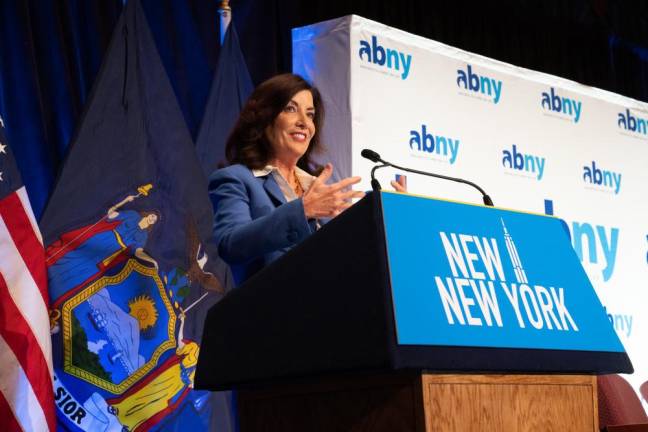Penn Station and the New New York
Hochul and Adams unveil a 40-point plan to guide the city out of the pandemic wreckage


Governor Kathy Hochul was told by a key legislator that she must come up with a new plan for rebuilding Penn Station and its neighborhood. She hasn’t done that, yet. But whether she meant to our not she may have laid out some of the key points a new plan needs to take account of.
“We can and must do better,” said the legislator, State Senator Leroy Comrie of Queens.
Comrie is a crucial figure because he not only chairs the Senate’s committee on Corporations, Authorities and Commissions, but also represents the Senate Democrats on the powerful Public Authorities Control Board, which has the power to block the governor’s redevelopment plans.
The senator spoke at a forum held by Crain’s, the real estate publication. There was general consensus among the participants that the governor’s current plan, which would use some of the revenue from building ten new office towers to help finance the rehabilitation of Penn Station, is moribund because her principal development partner Vornado Realty Trust, has retreated in fear of vacant office space, high interest rates and the shaky economy.
The governor at a separate event said again that she plans to press ahead, but she has so far been silent on what a revised plan might look like.
But at that other event she did offer a potential roadmap, whether she intended to our not.
Reimagining Manhattan’s Business Districts
At almost the exact moment that Comrie, was sending the governor back to the drawing board on Penn Station, the governor was with Mayor Adams unveiling a 40-point plan to create a “New New York” from the wreckage of the pandemic.
Central to this plan, created by a task force lead by two former deputy mayors, is the reimagining of Manhattan’s central business districts.
“Transforming our business districts into more vibrant, complete neighborhoods will simultaneously create more homes, which will address our housing crisis, and enliven public spaces, which will improve public safety,” the plan says. “The people attracted to these great new destinations will help lower retail vacancy rates and attract new employers, while also supporting local retailers and generating new jobs.”
The report notes that recovery in the core business areas of Manhattan is lagging well behind other business areas more closely aligned with local residents. The fundamental problem is the decline of office work.
“Now that New Yorkers increasingly have choices about where to work, many are opting out of their daily commutes,” the plan says.
That is a crisis both for the neighborhoods that depended on those workers and the subway, bus and commuter systems that carried them and depended on their fares.
“Ridership has plummeted across almost every regional system during peak commuting hours. Across all weekdays in November 2022, subway use averaged 62 percent of pre-pandemic levels, and bus use averaged 64 percent. Regional rail fared slightly better, with Metro-North Railroad and Long Island Rail Road weekly ridership averaging 68 and 67 percent of pre-pandemic levels over the same period.”
A “1970s Plan”
No place is this disruption of office work and commuting more relevant than in and around Penn Station.
But the governor’s plan was developed before the pandemic, by the previous governor, in fact, and is a “1970s plan,” said Comrie. Another panelist, Layla Law-Gisiko, who chairs the community board’s land use committee, said the plan smacked of old-fashioned urban renewal, demolishing blocks without thinking broadly about the neighborhood.
Thinking broadly is just what the “New New York” proposal urges.
The governor’s staff did not respond to questions about how the New New York plan should be applied to Penn Station and its neighborhood. But some of the plan’s 40 points seemed to be directly relevant.
1. Make Midtown and other business districts more live-work-play.
The current plan calls for lots of new office space and a bit more housing. The obvious question based on the New New York plan is, should there be a lot more housing? The New New York plan calls, for example, for making it easier to convert underused office buildings to residential, as happened in lower Manhattan after 9/11.
Officials of the Empire State Development Corporation, which oversees the Penn Station neighborhood redevelopment, have said, in fact, they expect some of this to happen as the spanking new office towers in their plan drain tenants from older buildings. But it is not laid out explicitly.
4. Create a world-class network of public space in Midtown
The Governor’s Penn Station plan does create more public space, but whether any of it is world class would be hotly contested by critics. One of the proposals offered as an alternative to the governor’s plan would move Madison Garden, making way for both an above ground train hall for commuters and a park roughly the size of Bryant Park.
14-17. Offer new reasons to go to business districts
The Penn Station area already has, of course, one of the city’s premier reasons to come to a business district other than business, Madison Square Garden. But the Garden has turned into one of the principal flashpoints around the redevelopment. Many critics say there is no way to build a proper train station without moving the Garden from on top of it, as the Garden was told it would have to do ten years ago.
“It’s not going to happen, okay,” said Louis Colletti, head of the Building Trades Employers Association. “I’m tired of endless debate. Debates about trying to move our economy forward, this city needs revenue, jobs, and it needs a project of this scope. Understanding that there’s a lot that has to be changed in the plan that’s been presented.”
Tom Wright, head of the Regional Plan Association, said he had long fought to move the Garden, but has more recently been convinced that a proper renovation of Penn Station can be achieved without the likely delays caused by waiting for an agreement with the Garden’s owner, James Dolan.
18-24. Increase supply of mass transit options
Some of the urgency to move ahead on a Penn Station plan is that the federal government is offering billions in infrastructure money tied to the expansion of rail access from New Jersey into Manhattan, the so called gateway project. This project will dramatically increase the capacity to bring travelers into Manhattan, whether for work or play.
One of the critiques of the governor’s plan, from Comrie and others, is that it does not do enough to create a modern rail network in which commuter trains can run straight through from New Jersey and the south to Long Island and points north. The principal users of the station, Amtrak, Long Island Railroad and New Jersey Transit, operate more or less independently of each other.
Beyond the myriad of details, participants in the Crain’s forum were unanimous on one thing, if that is possible for a New York development issue. Richard Ravitch, the former lieutenant governor and MTA chair, recommended that Hochul sit down first with the governor of New Jersey and then with Mayor Adams to craft a new plan that can win the support of business, labor and the community.
“Transforming our business districts into more vibrant, complete neighborhoods will simultaneously create more homes, which will address our housing crisis, and enliven public spaces, which will improve public safety.” From the “New New York” plan